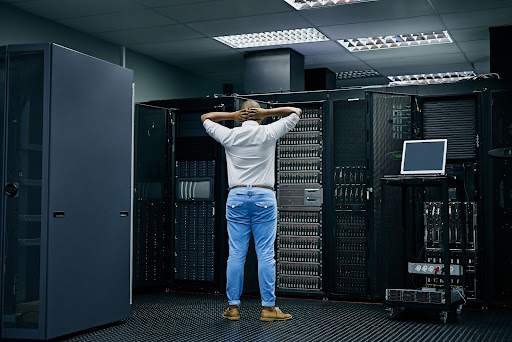Organizations across every industry are abandoning traditional on-premise IT infrastructure in favor of the cloud.
The challenge: What happens to outdated on-premise servers as businesses migrate to the cloud?
As companies embrace the cloud, their once-critical on-premise servers are becoming obsolete. These aging assets are not only expensive to maintain but also pose serious environmental, security, and financial risks.
Addressing outdated servers isn’t just an IT issue—it’s a business imperative.
Cloud Adoption Trends Driving Server Obsolescence

Reliance on public cloud providers like AWS, Google Cloud, and Microsoft Azure has grown, driven by their flexibility, scalability, and cost-efficiency.
AI-driven cloud management tools now help IT teams auto-scale resources based on demand, optimizing their infrastructure usage. This further reduces the need for in-house server hardware, causing massive hardware turnover.
Industries such as finance, healthcare, and manufacturing face unique pressures to migrate to the cloud to meet growing customer demands and stay competitive.
The cloud computing market has reached a valuation of $84 billion, and for good reason. AWS, Microsoft Azure, and Google Cloud have all showcased strong performance and customer success stories that emphasized innovation, efficiency, and cost savings across industries.
Risks and Costs of Maintaining Outdated Servers
Clinging to legacy servers comes at a steep cost. Businesses that delay upgrading or decommissioning their aging infrastructure face several significant drawbacks:
- High Operational Costs: Older servers consume more power and require constant maintenance. Cooling these inefficient machines further increases energy costs and carbon emissions.
- Increased Security Risks: Legacy systems often run outdated operating technology that no longer receive security patches, making them easy targets for cybercriminals.
- Compliance Gaps: New regulations (such as GDPR, HIPAA, or PCI-DSS) require modern security controls that older hardware cannot support, putting organizations at legal risk.
- Performance Bottlenecks: Outdated infrastructure can’t keep up with modern applications, slowing productivity and impacting user experience.
- Competitive Disadvantage: Companies that don’t modernize IT operations risk falling behind more agile, cloud-first competitors who can innovate faster.
The E-Waste Crisis: Managing Outdated Server Hardware
As businesses move to the cloud, legacy servers often get left behind, and improperly handling them can lead to environmental harm, data breaches, and missed opportunities for responsible disposal.

Environmental Impact
Old servers contain toxic materials like lead and mercury, which can contaminate soil and water if dumped in landfills. Recycling through certified programs helps reduce pollution and recovers valuable resources like copper and rare earth metals.
Data Security Concerns
Outdated servers may still store sensitive data. Without certified data destruction, companies risk major breaches. Secure erasing methods like shredding or NIST-compliant wiping are essential to protect business and customer information.
Recycling and Repurposing Servers
Certified electronics recyclers follow strict standards for safe disposal and data protection. They provide documentation, ensure compliance, and help businesses dispose of hardware responsibly.
Case Studies and Real-World Examples
It is clear that migrating to the cloud has been successful for companies in all industries.
One company in the financial sector switched to AWS cloud. With 70% of its application delivery management pipelines automated, they were unburdened of technical debt and posted a 19% year-over-year efficiency improvement. But they faced challenges in disposing of outdated data center hardware.
A global beverage manufacturer moved its customer engagement and collaboration platform to the Google Cloud Platform (GCP), improving its supply chain efficiency and delivering personalized experiences to its customers.
A global leader in gases, technologies, and services industry leveraged AWS cloud, and they were able to close their data center in just 5 months and save 30% of operational costs.
But 80% of large enterprises have stockpiles of out-of-use equipment in storage, and 57% take longer than two weeks to erase data from these devices. These delays, as well as any inadequate data sanitization processes, can increase the risk of data breaches and non-compliance.
Additionally, two in five companies with in-house data storage spend over $100,000 annually maintaining unusable hardware, many due to challenges associated with data security and compliance.
So what is the answer?
Business Solutions: What Companies Can Do
To manage the transition from legacy infrastructure and minimize negative impact, companies should implement the following strategies.
Partnering with E-Waste Management Firms
Working with certified e-waste management firms ensures that outdated servers are disposed of in an environmentally responsible way. These partners follow strict industry regulations for handling hazardous materials, reducing environmental harm, and mitigating the risk of non-compliance with local and federal waste disposal laws.
In addition, they offer certified data destruction services to guarantee that sensitive company information is permanently and securely erased from all hardware.
IT Asset Disposition (ITAD) Strategies
A well-defined ITAD strategy is essential for any business undergoing a digital transformation. By assessing the value and condition of legacy hardware, companies can determine which assets can be resold, refurbished, or donated to extend their lifecycle.
This process not only recovers value from depreciated equipment but also ensures data-bearing devices are tracked, wiped, and retired securely, minimizing the risk of data breaches and regulatory violations. A robust ITAD plan also supports documentation and reporting, which can be useful for audits and internal ESG reporting.
Cloud Migration Planning
Too often, companies focus only on migrating applications and data to the cloud without considering the fate of the hardware left behind. Businesses can streamline the transition process by integrating server decommissioning and disposal planning into the initial cloud migration roadmap.
This reduces downtime, prevents last-minute logistical headaches, and avoids unnecessary storage and energy costs associated with idle legacy equipment. Proactive planning also allows businesses to coordinate ITAD efforts alongside cloud providers and minimize operational disruptions.

Compliance with Sustainability Initiatives
Sustainability is no longer just nice to have, it’s a core expectation for modern businesses. As environmental, social, and governance (ESG) standards gain prominence among investors, customers, and regulators, companies must demonstrate a commitment to eco-friendly practices.
Server recycling and responsible IT asset disposition are tangible ways to reduce carbon footprints, divert e-waste from landfills, and meet internal sustainability benchmarks. By reporting on these efforts, companies can strengthen their ESG narratives and differentiate themselves as socially responsible industry leaders.
Recycle Your Outdated Servers Responsibly
As businesses modernize and migrate to the cloud, outdated on-premise servers become more than a technical burden—they become a business risk. From rising operational costs to environmental impact and security concerns, the consequences of ignoring server obsolescence are too great to overlook.
By partnering with certified ITAD providers like Great Lakes Electronics Corporation, businesses can responsibly recycle outdated servers, ensure secure data disposal, and align their digital transformation with environmental responsibility.
Don’t let outdated servers hold you back. Embrace the cloud, plan for lifecycle management, and recycle smarter—for your bottom line and the planet. Request a quote today!

